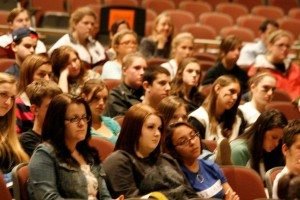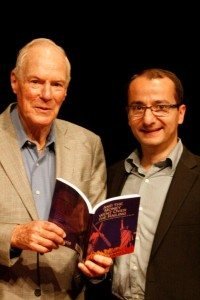CHELMSFORD, Mass.—Busra Cetin is an exchange student from Antalya, Turkey.

She sat with 250 students inside an auditorium at Chelmsford High School, perhaps squirming a bit while listening to Weekly editor and doctoral candidate Khatchig Mouradian talk about denial of the Armenian Genocide.
The more she listened, the more she heard.
“It’s good to hear about this,” she said. “In my country, we deny the genocide. I should read more of the books.”
Asked what can be done to resolve this grim dilemma for nearly a century, Cetin looked toward harmony.
“There should be some resolve between the two countries, a better understanding,” she pointed out. “That would mean relaxing the borders.”
The panel discussion April 12 was sponsored by the Armenian Genocide Education Committee of Merrimack Valley in collaboration with Facing History and Ourselves. It followed a full day of classroom presentations to 140 students three weeks before.
The genocide curriculum is among the more popular electives at the school, taught by Jennifer Doak and Stephanie Pally. The two launched a “Be the Change” project, encouraging students to stand against intolerance, prejudice, and discrimination as ways to prevent hostility in the outside world.
“We realize that the best route toward positive change is through awareness and understanding,” said Doak. “Even the more passive students are being impacted by the personal connections. It’s one thing to teach genocide and another to hear these accounts first-hand.”

Mouradian shared the podium with James Vanderpol, an 87-year-old Holocaust survivor from the Netherlands; Jasmina Cesic, the first Bosnian refugee to arrive in America; and Sayon Soeun, a child soldier taught to kill his fellow man.
Also joining the audience was George Simonian, who served as principal from 1972-88 and has the athletic stadium named after him. Simonian remains ecstatic over such a curriculum.
“This generation of Americans has to be made aware of past genocides because they’re being repeated,” he noted. “Most of these students don’t know what man’s inhumanity is all about. The best way to promote awareness is through these types of presentations. It has to become an integral part of the overall curriculum. I’m happy with programs like Facing History and the Genocide Education Committee for the work they’re providing to our educational welfare.”
Of the four panelists, Mouradian was the only non-survivor. He talked about growing up surrounded by survivors of the Armenian genocide, and about how their numbers have dwindled over the years.
Mouradian urged students to fight against human rights violations by staying connected to world events and respecting one another’s heritage.
“It is easy,” Mouradian said, “to make resolutions for the undetermined future. To tell oneself ‘I will have more time to get involved when I graduate, when I have a job’…. It’s not about age. It’s about choices—finding that one hour in your day, one day in your month, to get involved and make a difference in the world.”
Vanderpol described his experience as similar to that of Anne Frank, whose diary captivated the world. He survived the Nazi invasion of Amsterdam by hiding in a chimney and avoiding Hitler’s army for five years as a teenager. A potato was worth the price of gold.
He shared two thoughts with the students: “Money does not buy you happiness,” he said, adding, “Put aside any selfish attributes and don’t skirt honesty.”
“The real basic thing in life is love,” he continued. “A sense of humor became an anecdote for fighting terror. Learn your history and find solutions to serious problems. Always challenge yourselves. It’s the best way to establish a critical democracy.”
Cesic survived the genocide in Bosnia-Herzegovina during the early 1990’s when 200,000 Muslims were killed or starved to death in concentration camps. She lost a newlywed husband who was her high school sweetheart, two brothers, an uncle, grandmother, countless friends and colleagues—and her right arm.
She found her way to America, secured a business degree, opened a small real estate office, and authored a book on her experiences.
“Value your education,” she reminded the students. “If you ever become exposed to hostility, knowledge and understanding will be your greatest weapons. Only recently did the Serbs apologize for their crimes. Such an apology will open the door for future generations.”
At the age of nine, Soeun was holding an assault rifle and was taught to kill his fellow Cambodians, including members of his own family. Kill or be killed was his mantra.
“The government told me my parents and siblings were my enemy,” he related. “Love was forbidden. My soul belonged to the regime and I grew up thinking immunity was common practice.”
Today, Soeun is an activist who sets out to educate students, a role he’s played for over two decades as a former member of the Massachusetts Juvenile Justice Advisory Committee.
Similar genocide programs have taken place throughout other Merrimack Valley and Greater Boston schools. On April 24, a panel discussion will take place at UMass Lowell, arranged by sociology professor Dr. Levon Chorbajian and committee chairman Dro Kanayan.
Local newspapers have publicized the events their front page, while community access television has aired them for the viewing public.


in the bosnian case, i had read the number of dead was in the range of several thousand or over ten thousand; so, is it actually 200,000 ?